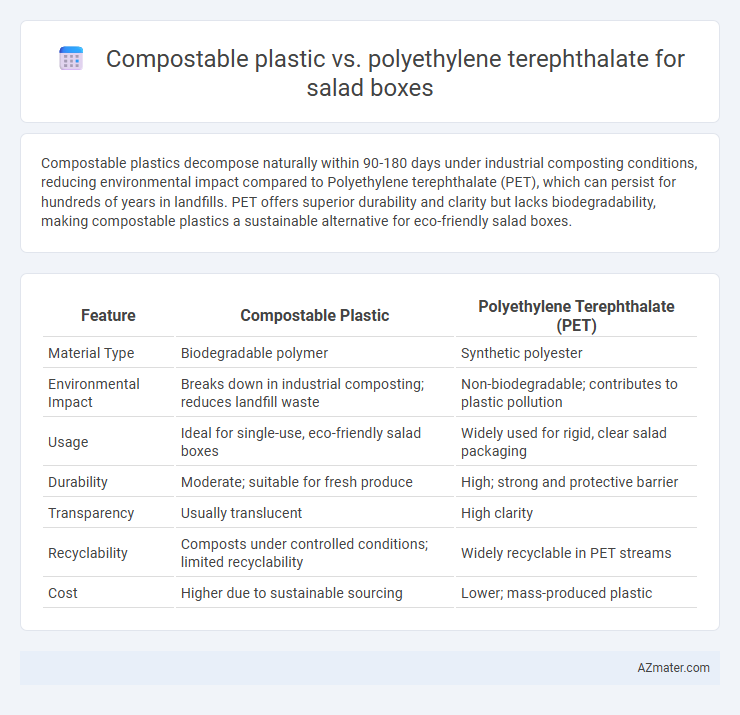Compostable plastics decompose naturally within 90-180 days under industrial composting conditions, reducing environmental impact compared to Polyethylene terephthalate (PET), which can persist for hundreds of years in landfills. PET offers superior durability and clarity but lacks biodegradability, making compostable plastics a sustainable alternative for eco-friendly salad boxes.
Table of Comparison
| Feature | Compostable Plastic | Polyethylene Terephthalate (PET) |
|---|---|---|
| Material Type | Biodegradable polymer | Synthetic polyester |
| Environmental Impact | Breaks down in industrial composting; reduces landfill waste | Non-biodegradable; contributes to plastic pollution |
| Usage | Ideal for single-use, eco-friendly salad boxes | Widely used for rigid, clear salad packaging |
| Durability | Moderate; suitable for fresh produce | High; strong and protective barrier |
| Transparency | Usually translucent | High clarity |
| Recyclability | Composts under controlled conditions; limited recyclability | Widely recyclable in PET streams |
| Cost | Higher due to sustainable sourcing | Lower; mass-produced plastic |
Introduction: The Importance of Sustainable Salad Packaging
Sustainable salad packaging is crucial for reducing environmental impact and promoting eco-friendly consumption habits. Compostable plastics, made from renewable resources like cornstarch or sugarcane, offer biodegradability and reduce landfill waste compared to traditional Polyethylene terephthalate (PET), which is derived from non-renewable petroleum and has a longer degradation period. Choosing compostable plastic for salad boxes supports zero-waste initiatives by enabling organic disposal, while PET provides durability and clarity but contributes to plastic pollution if not properly recycled.
What is Compostable Plastic?
Compostable plastic for salad boxes is designed to break down into natural elements through microbial activity within a composting environment, typically made from renewable plant-based materials like cornstarch or sugarcane. Unlike polyethylene terephthalate (PET), which is a petroleum-based plastic known for its durability and recyclability but persistence in the environment, compostable plastics aim to reduce landfill waste and environmental impact by decomposing within 90 to 180 days under industrial composting conditions. This makes compostable plastics a sustainable choice for salad packaging, aligning with eco-friendly waste management practices and reducing plastic pollution compared to conventional PET containers.
Understanding Polyethylene Terephthalate (PET)
Polyethylene terephthalate (PET) is a widely used plastic in salad boxes due to its excellent clarity, strength, and barrier properties that preserve freshness. PET is lightweight, recyclable, and resistant to moisture, making it a practical choice for food packaging that ensures product visibility and hygiene. Unlike compostable plastics, PET's extensive recycling infrastructure supports circular economy goals but requires proper sorting to prevent contamination.
Environmental Impact: Compostable Plastic vs PET
Compostable plastic salad boxes decompose naturally within months under industrial composting conditions, significantly reducing landfill waste and lowering greenhouse gas emissions compared to Polyethylene terephthalate (PET), which can take hundreds of years to degrade. PET salad containers often contribute to microplastic pollution and require energy-intensive recycling processes, whereas compostable plastics help close the loop through organic waste management. Despite the benefits, compostable plastics demand proper waste sorting infrastructure to fully realize their environmental advantages over PET in salad packaging.
Decomposition Rates and End-of-Life Scenarios
Compostable plastic salad boxes decompose within 90 to 180 days under industrial composting conditions, significantly reducing landfill accumulation compared to polyethylene terephthalate (PET), which can persist for over 400 years. PET salad boxes primarily follow recycling or landfill pathways, with recycling rates varying between 20% and 30%, often leading to long-term environmental persistence. Compostable plastics align with circular economy goals through organic waste integration, while PET's rigid molecular structure challenges rapid biodegradation and necessitates advanced recycling infrastructure.
Food Safety and Freshness Comparison
Compostable plastics, made from plant-based materials such as PLA, provide excellent breathability and moisture control, helping maintain salad freshness while naturally degrading without harmful residues. Polyethylene terephthalate (PET) offers superior barrier properties against oxygen and moisture, thereby preserving salad crispness and extending shelf life, but it is derived from non-renewable fossil fuels and requires specialized recycling processes. From a food safety perspective, PET is FDA-approved for direct food contact with minimal risk of chemical leaching, whereas compostable plastics may vary in compliance depending on the certification and production process.
Cost Analysis: Compostable Plastic vs PET for Salad Boxes
Compostable plastic salad boxes generally have higher material costs compared to polyethylene terephthalate (PET) due to limited production scale and raw material sourcing. PET offers lower manufacturing expenses and superior supply chain efficiency, resulting in cost-effective packaging solutions for large-scale salad box production. However, rising environmental regulations and consumer demand for sustainable alternatives may narrow the cost gap between compostable plastics and PET over time.
Consumer Perception and Market Trends
Consumer perception favors compostable plastic for salad boxes due to growing environmental awareness and demand for sustainable packaging solutions. Polyethylene terephthalate (PET), despite its widespread use for clarity and durability, faces criticism over recyclability challenges and plastic waste concerns. Market trends indicate increasing investment in compostable plastic innovations, driven by regulatory pressures and consumer preference shifts toward eco-friendly alternatives.
Regulatory and Certification Requirements
Compostable plastic salad boxes must meet ASTM D6400 or EN 13432 standards for biodegradability and compostability, ensuring compliance with stringent environmental regulations targeting organic recycling streams. Polyethylene terephthalate (PET) salad containers adhere to FDA and EU food contact safety regulations, emphasizing chemical inertness and recyclability under established municipal or industrial recycling programs. Certification bodies such as BPI (Biodegradable Products Institute) for compostable plastics and ISCC (International Sustainability & Carbon Certification) for PET ensure traceability and regulatory compliance throughout the supply chain.
Choosing the Best Material for Eco-Friendly Salad Packaging
Compostable plastic offers a biodegradable alternative to traditional polyethylene terephthalate (PET) for salad boxes, breaking down naturally within industrial composting environments and reducing environmental impact. PET provides exceptional strength, clarity, and barrier properties, ensuring freshness and shelf-life but poses challenges due to its persistence in landfills and low biodegradability. Choosing the best material for eco-friendly salad packaging involves balancing durability and recyclability of PET with the sustainability and compostability advantages of bioplastics, aligning with circular economy goals.

Infographic: Compostable plastic vs Polyethylene terephthalate for Salad box
 azmater.com
azmater.com